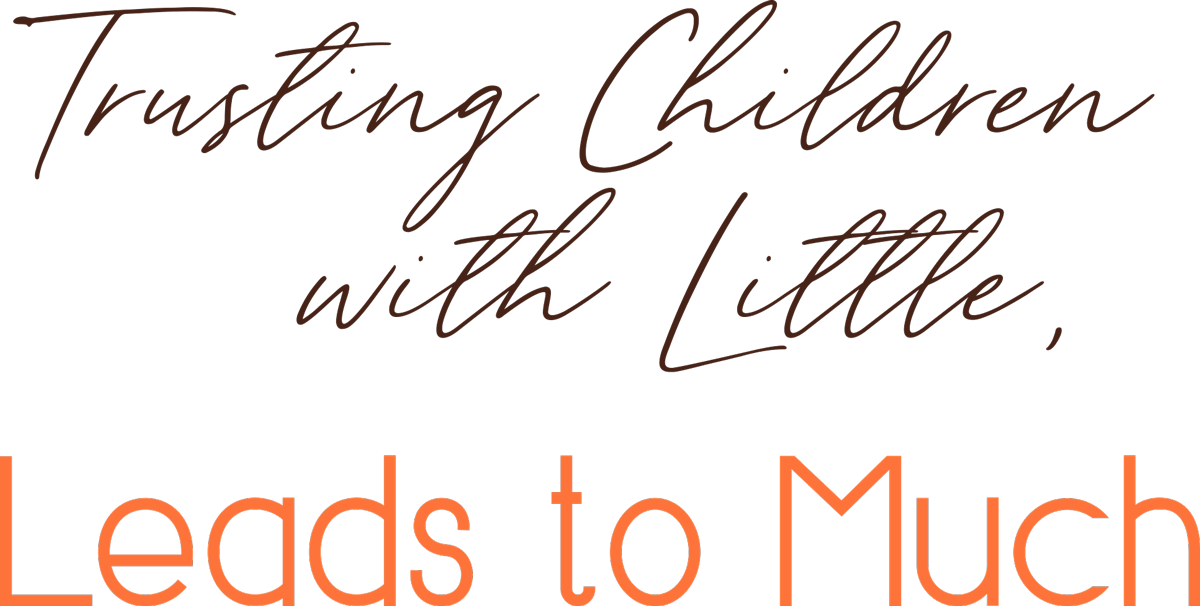

“He who is faithful in a very little thing is faithful also in much; and he who is unrighteous in a very little thing is unrighteous also in much.”
It’s hard, isn’t it, to say yes—to trust, to risk? Yet, our trust and risk are vital to our children learning how to be responsible. Responsibility is a part of leadership. As parents of young children, we play an essential role in the training, modeling, and empowering that fosters skills our children need to be leaders.
If I wanted my children to be trusted with much, I needed to give them opportunities to be trusted with little.
By the end of the week, the area looked very different. Math book covers were crinkled, glue oozed from the orange caps, and markers were everywhere but in the bin. I felt certain a tornado moved through the center of the room. Frustration and tension hung in the air. What made it worse was no one, including me, really wanted to take part in the recovery process. Looking at the debris of the week, I realized I missed a step: training for and modeling the clean-up process.
Mike encouraged me to pray through how I would back up and reset. He also encouraged me to observe what each child felt was important. My mover wanted to grab and go—grab a marker and get to business, grab the book and toss it on the shelf. My organizer liked the colored bins, but had more effective practical ideas (incidentally, they were much better than what I could have planned). My thinker pondered all the activities and wanted a quiet workspace. Every learner’s ideas had a place in our home, and each had something to contribute. I decided to put my ideas aside and come alongside their natural bents.
I started making changes, loosening my control and need for efficiency, but I also made sure the expectations were clear and I had modeled what would be acceptable. I asked where the marker bin should be stored, knowing if my children had a say in the process, there would be greater probability for them to take ownership. To my surprise, there were significant results. My children indeed took ownership and became confident in their contributions. We found a rhythm, but best of all each child knew they were capable of contributing to Team Bastian.
“If I wanted my children to be trusted with much, I needed to give them opportunities to be trusted with little.”
“If I wanted my children to be trusted with much, I needed to give them opportunities to be trusted with little.”

I prayed and wrestled through the fears. On the next visit to the grocery store, I asked the cashier to give my daughter the receipt, “You can hand her the receipt. She’s very responsible.” The cashier was confused until he saw my daughter’s eyes light up! A word of affirmation, a smile, a receipt, and a few coins empowered my daughter. I never imagined these things could be so uplifting. Fully engaged and feeling responsible, my daughter acted like she was guarding a million dollars! The seeds of responsibility and leadership were being watered.
My six year old observed the responsibility her younger sibling had taken and how much pride her sister had contributing. Knowing she also had the ability to contribute, the six year old volunteered to unlock the front door. She became the keeper of the car and house keys once I turned off the van and pulled the keys from the ignition. Once I handed her the keys, she bounded out the van door and ran to the front door. Again I observed how responsibility follows empowerment. My daughter had taken charge of unlocking the front door for the family.
Mike and two middle girls took a week-long road trip to the softball World Series. When I called to check in, one of the girls answered the phone. I was surprised, yet elated, to hear the proud voice on the other end exclaim, “Dad made me his secretary when he was driving.” She didn’t have her personal phone, so this was a special treat. Our daughter had met a need, was entrusted with a phone, and felt important. She knew she had the power to contribute to people’s lives in positive ways. Later in the week, she texted me a list of items she and her sisters needed at the store. With responsibility thriving, leadership began to blossom.
The mind-shift I had to make away from fear and the risks I had to take of losing some things I would rather have controlled—organized supplies, lost change, broken keys, or a dropped cell phone—paled in comparison to the training, modeling, and empowerment that led to greater responsibility in my children. Being faithful with small things has led to managing even more.
As our children have grown, I’ve witnessed how responsibility grows into leadership. My children learned that I trusted them with important things. They were perfectly capable of finding places for their books and making sure they had sharpened pencils. From responsibility with supplies came trusting them with making their daily schedule. And, from those experiences, they began to learn about themselves—where it would be best to read, how they could finish math quicker, or why they needed water nearby to stay hydrated. Figuring out who they were and how they worked best grew their ability to create their own schedules. Independence was a process, and my children knew I trusted them with trial and error, failure, and reworking. The process was a real-life part of developing self-awareness and leadership.
Supplies, receipts, house keys, and cell phones are practice steps to sitting in the driver’s seat of a car, taking dual enrollment courses, or walking down the aisle to their beloved. When those days came—as they have for our adult children—I knew each was ready. Each experienced a multitude of opportunities to prove their responsibility, trustworthiness, and leadership.
I remember sitting in the place reserved for the groom’s mother. I reflected on my son’s growing-up years, his readiness to not only be responsible for himself, but also to consider and weave the well-being of another person into his days. One day he was entrusted with bringing in his bike from the rain and feeding the hamster, another day how to use Grandfather’s fishing pole and scheduling his days. A year or so later, he was given command of a canoe of younger scouts and helped teach them first aid. Not too long after, he asked for the keys to our car.
And now, on his wedding day, he waited at the end of an aisle for his bride. I watched in amazement and with excitement. This was the day I had envisioned—trusting him with a little grew into trusting him with much. It came much quicker than I had anticipated.
heryl Bastian has been married to Mike for thirty years and began homeschooling in 1993. A mother of eight children—preschool through adult—Cheryl knows the trials and triumphs of embracing each season of life and is passionate about equipping and inspiring parents who want to nurture a desire for life-long learning in their children.